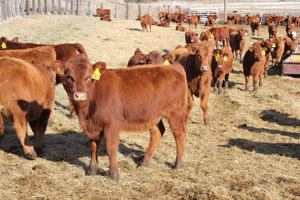Management, Health, and Nutritional Considerations for Weaning Calves … And Potentially Making You More Money
August 2015

Weaning time can be a stressful time for calves. Weaning calves at home and selling after the seasonal price pressure subsides can increase profitability. Reducing separation and handling stress, providing proper nutrition, and preconditioning against disease increases the value of the calves and improves their performance when they enter the growing and finishing period.
Calf health & other procedures at weaning
Using low-stress handling techniques to ease calves away from their mothers boosts the vaccinations calves were given before bull turnout. Vaccines should include:
- Bovine Respiratory Disease (BRD) virals including IBR (Infectious Bovine Rhinotracheitis), BVD (Bovine Virus Diarrhea), and BRSV (Bovine Respiratory Syncytial Virus);
- a BRD bacterial vaccine (examples include; Presponse, Pulmo-Guard, One-Shot, etc.); and
- a Clostridial such as a 7-Way Blackleg.
Calves are very susceptible to parasites and an effective dewormer should be given as well.
A growth implant approved for weaning calves will improve growth during the next 45 to 60 days post weaning for cattle not intended for replacement breeding stock.
Methods of separation
Separating calves from their dams causes behavioral changes that lead to stress. Vocalization, walking fences, and reduced intake can all result in reduced performance and health concerns. Producers should choose the separation method that works best for their operation while taking as many precautions as possible to maintain performance and reduce illness.
Traditional weaning
Traditional weaning is defined as separating the cows and calves abruptly without any residual contact. Calves may be moved away from the ranch, or they may be confined to a dry lot or a small pasture while the cows are taken away from the immediate area. Traditional weaning results in vocalization and fence walking which can last up to 3 days.
Fenceline weaning
Fenceline weaning (placing cows and calves on opposite sides of a fence) has been shown to result in fewer vocalizations, less fence walking, and more weight gain postweaning compared to traditional weaning of calves.
Fenceline weaning works best using a tight, 4-5 strand barbwire fence, reinforced with woven wire or electric fence. However, successful fenceline weaning has been accomplished with two strands of electric fence.
One key to successful fenceline weaning is ensuring the adjacent pastures share a fence long enough for the cows and calves to spread out and maintain relatively close physical proximity.
The process takes about 5-7 days. Fenceline weaning is best accomplished by removing cows from the pasture the pairs were occupying rather than moving the calves to a new pasture because the calves are accustomed to the watering location and feeding facilities. Introducing pairs into the weaning pasture about 1 week prior to weaning is sufficient for calves to become familiar with the pasture.
If calves are going to be supplemented, consider supplementing the pairs three days a week beginning about three weeks before weaning. This will teach the calves to eat supplement and familiarize them with the supplement truck.
Two-step weaning
At the time of preconditioning, a plastic nose piece (sometimes called a “weaner”) is placed in the calf’s nose which allows the calf to graze and drink water, but prevents nursing (step 1). Calves are then returned to the cows for 10-14 days. After day 10 to 14 placement of the plastic nose piece, calves and cows are separated (step 2). Research has shown this method decreases vocalization and walking by cows and calves. At the time of dam and calf separation, calves and cows can be handled like that described in the “traditional” weaning method.
Nutrition
Nutrition is a key element in the weight gain and immune response of weaned calves. Milk is rich in energy, protein, and vitamins and minerals and needs to be replaced with high quality forage and possibly supplement to maintain preweaning nutrient intake. Fortifying the pre- and post-weaning diet with vitamins and minerals can contribute to improved immune function and reduced post- weaning sickness.
Unlimited access to fresh, clean water is essential for weaned calves. If the post weaning water source is unfamiliar to the calves, make accommodations to familiarize the calves. Allowing the water source to overflow for a brief time may help calves find the water.
Weaning on grass
If calves are allowed to continue grazing after weaning, consider the nutrient content of the forage. Native range in the fall is in a state of declining nutrient content. Weaned calves grazing native range in the fall may require supplemental feed depending on the targeted weight gain.
Weaning in dry lot
Calves moving from grazing to dry lot for weaning must learn to eat from a bunk. Bunk space needs to be adequate (1.5 – 2 ft/hd) for the number of calves being weaned. Adding fill dirt around bunks and water may be necessary to ensure small calves can reach water and feed.
Reduced intake typically results in poor weight gain and depressed immune function. Therefore, maintaining feed intake is crucial. Feeding long-stem high-quality grass hay the first two or three days post-weaning, works well to start calves on feed. After two or three days, begin adding some energy feeds to the diet. The diet can be delivered as a total mixed ration or the energy feed can be top-dressed on the hay.
Fermented feeds such as silage should be avoided until calves are eating well, as it is not highly palatable to them. Additionally, energy is important but energy sources high in starch such as corn should be limited to 50% or less of the dietary dry matter.
Additional information
For more detailed information on weaning management please refer to the NebGuide G2057 Management, Health, and Nutritional Considerations for Weaning Calves (PDF version, 307KB).
Karla H. Jenkins
Nebraska Extension Beef Specialist/Range Management Specialist
Dee Griffin
Nebraska Extension Feedlot Veterinarian
Aaron Stalker
Former Nebraska Extension Beef Nutrition Specialist